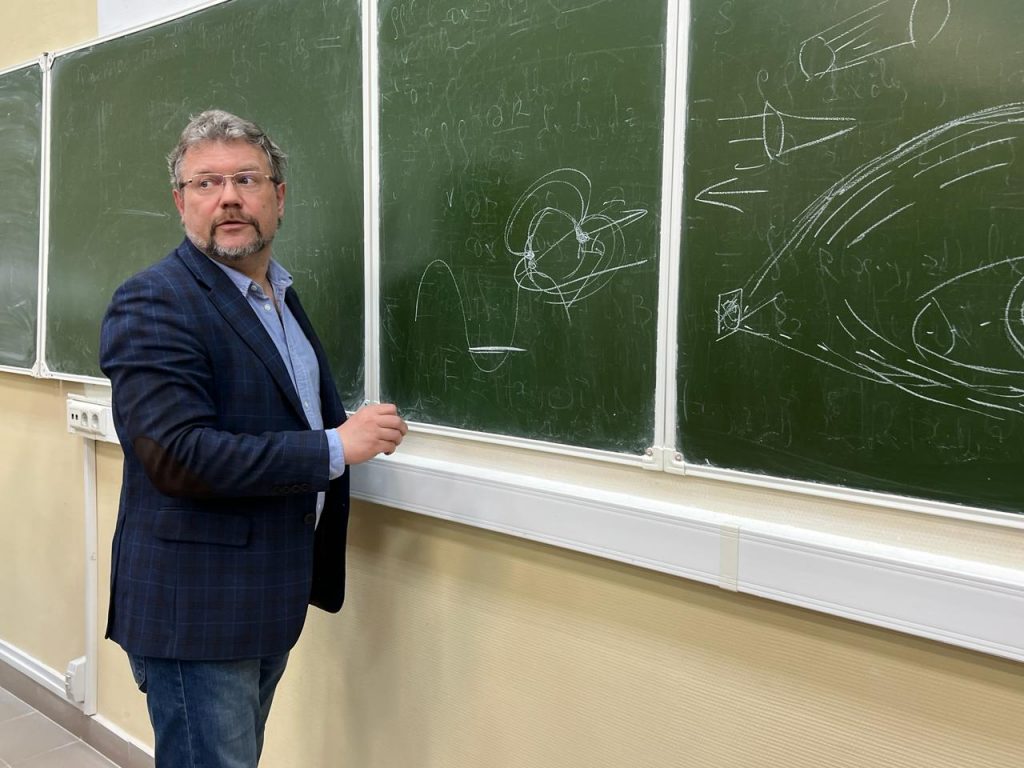KFU, Roscosmos and Russian Academy of Sciences experts discuss results obtained by Spektr-RG orbital observatory

An astrophysical seminar was held at the Institute of Physics before Cosmonautics Day. It presented new scientific results obtained by Spektr-RG, including using optical observations on the Kazan University astronomical mirror telescope AZT-22 which is installed in Turkey (RTT-150).
The event was attended by representatives of the Roscosmos Corporation, the Institute of Space Research of the Russian Academy of Sciences, as well as scientists and students of KFU.
Launched in 2019, Spektr-RG is designed to study the Universe in the soft (0.3-8 kilo-electron-volt) and hard (4-30 kilo-electron-volt) X-ray energy range using two oblique incidence X-ray telescopes – Germany’s eROSITA and Russia’s ART-XC, respectively. The instrument operates at the Lagrangian point L2 at a distance of 1.5 million kilometers from the Earth. The data obtained make it possible to map the entire sky in the X-ray energy range and obtain new unique data on the nature of black holes, neutron stars, active galactic nuclei, and massive galaxy clusters.
Deputy Director of the Institute of Space Research Alexander Lutovinov presented his rreport SRG Observatory: current status, results, observation program; then Vladimir Nazarov, Head of the Department of Ground-Based Scientific Complexes of said institute, told about the ground-based scientific complex of SRG, which is responsible for receiving X-ray data from the observatory using a system of large radio telescopes with mirror diameters of 64-70 meters. Professor Ilfan Bikmaev‘s (Department of Astronomy and Space Geodesy, Institute of Physics) report was titled Search for distant quasars and close double star systems detected by SRG by optical observations on RTT-150. In conclusion, High-precision astrometry for ballistic problems of SRG on observations on the telescope RTT-150 was presented by Irek Khamitov, Senior Research Associate of the Laboratory of Astrophotometry and Stellar Atmospheres of the Institute of Physics.
Reporting on the results of the research, Alexander Lutovinov emphasized that the ART-XC telescope detected a large number of new objects, including unique ones, including, for example, a micro-quasar and a new black hole near the center of our Galaxy. A few months ago, the telescope saw it being born and recorded all phases of its outburst.
“At the end of February 2024, we detected a bright new source in the X-ray sky – a very fast rotating neutron star with a magnetic field. This star pulsates with a very short period of 2.2 milliseconds, and in addition, thermonuclear explosions occur on its surface”, informed the scientist.
Lutovinov said that based on the results of the AWG data processing, a lot of scientific papers have been published, including joint papers with Kazan University astronomers.
“Soon a new scientific paper with a complete catalog of objects detected in the hard X-ray range will be published. There are over 1,500 names,” shared Lutovinov.
Speaking about the central regions of our galaxy, he noted that the number of X-ray sources detected there thanks to ART-XC data has increased by more than 25 percent.
“In October 2023, we completed a deep survey of the galactic plane. Data analysis is in full swing. I hope that young KFU astronomers will join in identifying objects and compiling the catalog,” he emphasized.
Vladimir Nazarov said in an interview that SRG will soon be five years old.
“And exactly the same number of years of our joint work with KFU astronomers to process data obtained by this space observatory,” he noted. “Now we have the time to summarize the results. Today’s seminar showed that we have something to be proud of. Our results are very good. For such a space observatory to work successfully, it is important to ensure not only uninterrupted data transmission, but also planning, including scientific planning, as well as continuous processing of the results so that it is possible to plan a space experiment. In addition, it is also important to support navigation parameters”.
According to Nazarov, the project participants work very harmoniously, almost around the clock, without weekends and holidays.
“We came to KFU to take part in the seminar and the meeting. We discussed organizational issues related to the possibility of involving the Kazan University’s RTT-150 telescope in Spektr-RG’s work. We now have a contract for flight tests until 2025. The next contract will start in 2026,” said Kirill Borisov, Department Head at the State Corporation Roscosmos.
He added that Roscosmos is the commissioner of the Spektr-RG project, while the Russian Academy of Sciences is the thematic client. The Institute of Space Research is responsible for the implementation of the scientific program.
“The planned term of active existence of SRG is 6.5 years, until the beginning of 2026,” Borisov specified. The next federal space program will provide funds for flight tests beyond this period. We hope that this spacecraft will operate for as long as possible.”

